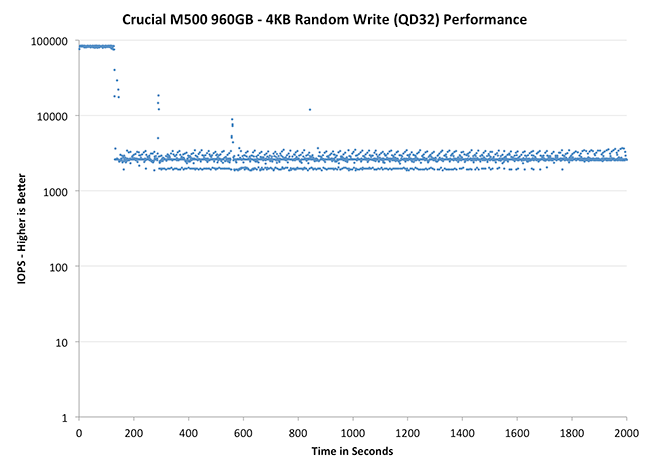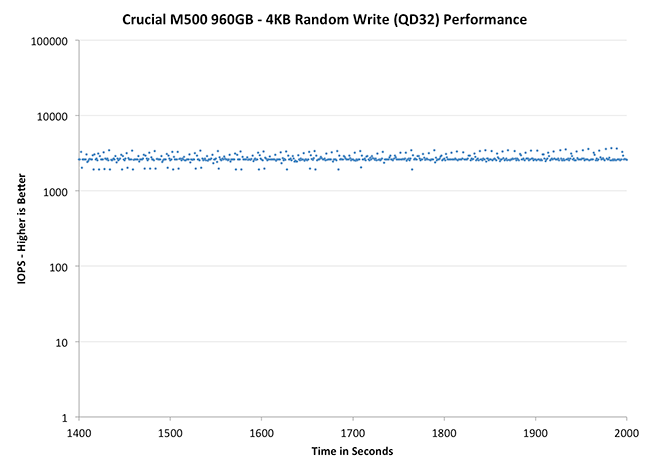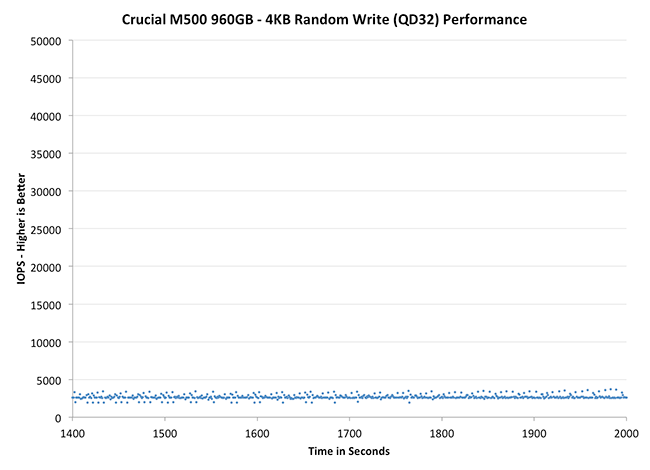The Crucial/Micron M500 Review (960GB, 480GB, 240GB, 120GB)
by Anand Lal Shimpi on April 9, 2013 9:59 AM ESTPerformance Consistency
In our Intel SSD DC S3700 review I introduced a new method of characterizing performance: looking at the latency of individual operations over time. The S3700 promised a level of performance consistency that was unmatched in the industry, and as a result needed some additional testing to show that. The reason we don't have consistent IO latency with SSDs is because inevitably all controllers have to do some amount of defragmentation or garbage collection in order to continue operating at high speeds. When and how an SSD decides to run its defrag and cleanup routines directly impacts the user experience. Frequent (borderline aggressive) cleanup generally results in more stable performance, while delaying that can result in higher peak performance at the expense of much lower worst case performance. The graphs below tell us a lot about the architecture of these SSDs and how they handle internal defragmentation.
To generate the data below I took a freshly secure erased SSD and filled it with sequential data. This ensures that all user accessible LBAs have data associated with them. Next I kicked off a 4KB random write workload across all LBAs at a queue depth of 32 using incompressible data. I ran the test for just over half an hour, no where near what we run our steady state tests for but enough to give me a good look at drive behavior once all spare area filled up.
I recorded instantaneous IOPS every second for the duration of the test. I then plotted IOPS vs. time and generated the scatter plots below. Each set of graphs features the same scale. The first two sets use a log scale for easy comparison, while the last set of graphs uses a linear scale that tops out at 40K IOPS for better visualization of differences between drives.
The high level testing methodology remains unchanged from our S3700 review. Unlike in previous reviews however, I did vary the percentage of the drive that I filled/tested depending on the amount of spare area I was trying to simulate. The buttons are labeled with the advertised user capacity had the SSD vendor decided to use that specific amount of spare area. If you want to replicate this on your own all you need to do is create a partition smaller than the total capacity of the drive and leave the remaining space unused to simulate a larger amount of spare area. The partitioning step isn't absolutely necessary in every case but it's an easy way to make sure you never exceed your allocated spare area. It's a good idea to do this from the start (e.g. secure erase, partition, then install Windows), but if you are working backwards you can always create the spare area partition, format it to TRIM it, then delete the partition. Finally, this method of creating spare area works on the drives we've tested here but not all controllers may behave the same way.
The first set of graphs shows the performance data over the entire 2000 second test period. In these charts you'll notice an early period of very high performance followed by a sharp dropoff. What you're seeing in that case is the drive allocating new blocks from its spare area, then eventually using up all free blocks and having to perform a read-modify-write for all subsequent writes (write amplification goes up, performance goes down).
The second set of graphs zooms in to the beginning of steady state operation for the drive (t=1400s). The third set also looks at the beginning of steady state operation but on a linear performance scale. Click the buttons below each graph to switch source data.
 |
|||||||||
| Corsair Neutron 240GB | Crucial m4 256GB | Crucial M500 960GB | Plextor M5 Pro Xtreme 256GB | Samsung SSD 840 Pro 256GB | |||||
| Default | |||||||||
| 25% Spare Area | |||||||||
Like most consumer drives, the M500 exhibits the same pattern of awesome performance for a short while before substantial degradation. The improvement over the m4 is just insane though. Whereas the M500 sees its floor at roughly 2600 IOPS, the m4 will drop down to as low as 28 IOPS. That's slower than mechanical hard drive performance and around the speed of random IO in an mainstream ARM based tablet. To say that Crucial has significantly improved IO consistency from the m4 to the M500 would be an understatement.
Plextor's M5 Pro is an interesting comparison because it uses the same Marvell 9187 controller. While both drives attempt to be as consistent as possible, you can see differences in firmware/gc routines clearly in these charts. Plextor's performance is more consistent and higher than the M500 as well.
The 840 Pro comparison is interesting because Samsung manages better average performance, but has considerably worse consistency compared to the M500. The 840 Pro does an amazing job with 25% additional spare area however, something that can't be said for the M500. Although performance definitely improves with 25% spare area, the gains aren't as dramatic as what happens with Samsung. Although I didn't have time to run through additional spare are points, I do wonder if we might see better improvements with even more spare area when you take into account that ~7% of the 25% spare area is reserved for RAIN.
 |
|||||||||
| Corsair Neutron 240GB | Crucial m4 256GB | Crucial M500 960GB | Plextor M5 Pro Xtreme 256GB | Samsung SSD 840 Pro 256GB | |||||
| Default | |||||||||
| 25% Spare Area | |||||||||
I am relatively pleased by the M500's IO consistency without any additional over provisioning. I suspect that anyone investing in a 960GB SSD would want to use as much of it as possible. At least in the out of box scenario, the M500 does better than the 840 Pro from a consistency standpoint. None of these drives however holds a candle to Corsair's Neutron however. The Neutron's LAMD controller shows its enterprise roots and delivers remarkably high and consistent performance out of the box.
 |
|||||||||
| Corsair Neutron 240GB | Crucial m4 256GB | Crucial M500 960GB | Plextor M5 Pro Xtreme 256GB | Samsung SSD 840 Pro 256GB | |||||
| Default | |||||||||
| 25% Spare Area | |||||||||










111 Comments
View All Comments
philipma1957 - Thursday, April 18, 2013 - link
it is all about how much you want to pay. if you buy 1 960gb micron ssds and buy a pegasus r4. with 41tb hdds you can get a very fast booting mac setup. cost is 600 + 999 or 1600. pull one 1tb hdd from the pegasus and put in the micron 960gb ssd. you have a 1tb ssd as your boot drive and 3 x 1tb hdds for storage along with a 1tb hdd as a spare.. but that is a 1600 solution pretty high costUmika - Monday, April 22, 2013 - link
I have now one of these M500 SSDs and I have actually managed to lock me out of the drive using 3rd party OPAL TCG software. Now the printed PSID comes into play: I have downloaded the Seagate SeaTools utilities for Windows to try to crypto erase the SSD, but to no avail - the SeaTools always terminate with an error message. Is there any other openly available software to try to erase or PSID revert the drive to factory settings?gzon - Tuesday, April 23, 2013 - link
I am also experiencing problems with the OPAL encryption. Windows 8 does not seem to revert the disk back to manufactured-inactive state. Also tried PSID revert with SeaTools but it did not work. Where can I find software to PSID revert the disk?mikato - Tuesday, April 23, 2013 - link
"the key is just stored in the controller and everything is encrypted/decrypted on the fly"What happens if the controller breaks somehow and you need data recovery? You're just screwed? Of course backing up is the best way to go but we all know not many people do that and with these large SSD sizes they'll be taking on more data and not just an OS and programs that can always be reinstalled.
odedia - Sunday, July 21, 2013 - link
I can just drool over the thought of putting two of these in my 17 inch Macbook Pro. I currently have a 128gb Intel SSD and a 500gb spinning drive. This will be a serious upgrade, and I'll be able to RAID0 them together for better performance and easier drive management.littlesandra88 - Tuesday, August 27, 2013 - link
How can an ATA BIOS password not be secure, if it changes the password (makes a new hash)?paaraa - Friday, November 29, 2013 - link
People always keep hammering about the Samsung SSD's, but did you know about the bad block issue they have? Look up the 'SSD Endurnce Experiment' (the 200TB update) at Tech Report and you will see the bad block tally of the Samsung being way up there.New Egg current (black friday) has the 480gb M500 on sale for $279, pretty good. I have two M4's (128gb) and they have been great for years now.
Gallopsu - Monday, December 23, 2013 - link
This article mentions increased performance by 25% over provisiong. Is this something that must be configured in the bios or firmware. Or is it accomplished by simply not filling it to capacity. Or should only format it to 768GB and leave the rest untouched? How can I confirm that it is actually working? Would hate to give up that space and not get the benefits.clifforama - Tuesday, January 21, 2014 - link
Have you had any response from Crucial regarding how to perform a PSID reset/revert?bogdan_kr - Thursday, January 23, 2014 - link
Yes, I would like to know that too. Crucial has not provided any information on their forums but I guess they could possibly send some more specific information to you Anand :-)